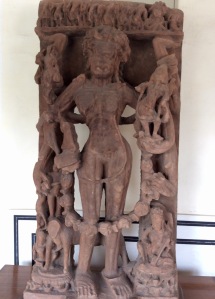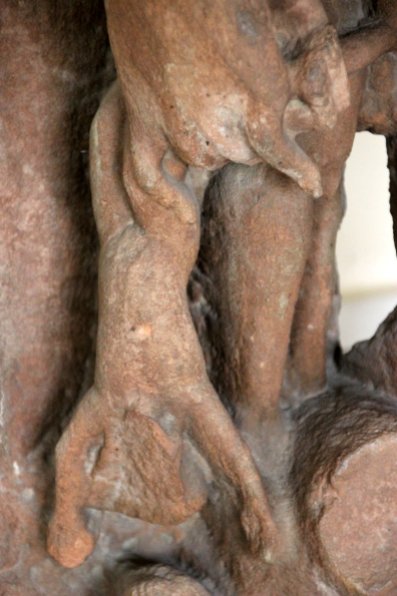Stories in Stone is all about sculptures — either standalone or entire narrative panels. Each post in this series showcase one such sculpture, look beyond its iconography and deconstruct the details in an attempt to understand the idea and/or the story it conveys.
 The Government Museum at Jhalawar has a stunning collection of sculptures on display. With a few exceptions, most sculptures are in a good condition and easily recognisable for what/who they represent.
The Government Museum at Jhalawar has a stunning collection of sculptures on display. With a few exceptions, most sculptures are in a good condition and easily recognisable for what/who they represent.
One large room/gallery is crammed with sculptures found from the nearby areas of Chandrabhaga, Jhalrapatan, Kakuni, etc.; more sculptures are exhibited in the corridor outside. Knowing how museums function, I’m pretty sure that only a fraction of the Museum’s collection is actually exhibited; there would be many more sculptures in storage.
There are dikpalas (or guardians of the directions), various forms of Shiva, Vishnu, and Devi, and some very interesting composite sculptures. But the sculpture which stood out for me, and is the topic of today’s post, was a poorly preserved, but recognisable sculpture of Chamunda (see photo on the left) placed in the corridor.
Before we get into the details of this sculpture, let us place Chamunda in context through her creation myth, associated stories and standard iconography.
According to the Devi Mahatmyam, Chamunda is a fierce form of Devi or the great goddess, and she emerged as Kali from Devi’s anger to battle demon armies. When Kali beheaded the demon generals, Chanda and Munda, and offered their heads to Devi, she was given the name Chamunda. An independent female power/divinity, who is not attached to any male divinity, Chamunda projects both fear and horror with her emaciated body, shrivelled and sagging breasts, protruding ribs and veins, shrunken, concave belly and sunken eyes. Chamunda is associated with death and destruction and when she goes on a rampage, she is capable of destroying the world, including the Gods themselves.
 Chamunda’s attributes include a munda mala or a garland of skulls; matted and tangled hair with snakes and skulls as hair ornaments, and fangs. Jackals and vultures are the animals associated with Chamunda and one can see the former as part of her iconography.
Chamunda’s attributes include a munda mala or a garland of skulls; matted and tangled hair with snakes and skulls as hair ornaments, and fangs. Jackals and vultures are the animals associated with Chamunda and one can see the former as part of her iconography.
She usually stands, sits or dances on a corpse, and depending on the number of arms she is portrayed with, holds a sword, trident, damru or kettledrum, skull staff, kapala or bowl made from a skull. An identifying (and according to me a rather quirky) attribute is of Chamunda holding a finger to her lips.
See the photograph on the right — it is not the Chamunda that is the subject of discussion in this post, but another one from the same museum, and same provenance, but made 300 years later. It has all the attributes that I have just described, including her feet placed on a corpse.
Chamunda is also associated with the matrikas or the mother goddesses, as also with the tantric and esoteric yoginis. Because she is the shakti of Devi Herself, she is considered to be the first or chief among the matrikas and the yoginis. Chamunda is also the only matrika to be worshipped independently; all other Matrikas are always worshipped together. See the photograph of the saptamatrikas below and how Chamunda is depicted — once again from the same museum at Jhalawar and same provenance, but made 300 years later.

Now that we have established the context, let us take a close look at the sculpture of Chamunda, whose story I hope to narrate by deconstructing her iconography.
This Chamunda has been carved from a single slab of an iron rich blackish red sandstone and is dated to the 8th century CE from Chandrabhaga, about 12 km from Jhalawar. She is about 5 ft tall, and while not mutilated, is not in a very good condition either. Her skeletal figure and veins are clearly visible and she is so emaciated that you can make out her spinal column through the rib cage. In spite of this, Chamunda’s slender and shapely form makes her somewhat of a grotesque beauty. Chamunda’s angry expression is quite palpable, but what I found most fascinating was Chamunda’s hair; even though details are not visible, one can imagine it as a writhing mass of snakes.

The information placard accompanying this sculpture at the museum says that it has 8 arms, which is incorrect. She has 10 arms — the 8 that you can (hopefully) make out in the photograph above, plus the two hands that go behind her back. Though some of the limbs are broken, let’s try and see what Chamunda holds in each of her hands — clockwise from top left, the navagrahas in one left and one right hand; a kapala; a figure who cannot be identified; something that cannot be made out; a corpse being held by its legs; a sword that is now broken; and another figure who cannot be identified.
In addition, there is a canine who is depicted standing behind Chamunda’s legs; though the head is missing, it is quite clearly a jackal or a dog. There are two unidentifiable figures — a male and female — seated on either side of her legs. Two more figures can be made out behind what would have been the jackal’s head and the dangling corpse.
The individual features and details have become fuzzy, which is not surprising considering the quality of the sandstone and the centuries of worship and offerings this Chamunda may have received. To see the details of the sculpture, you can click on any of the pictures to start a slide show. You can then use the left or right arrow keys to navigate through the rest of the pictures.
After having seen the context of Chamunda, in general, and also a close look at this particular sculpture, you will notice immediately that this is not a typical Chamunda, though most of the recognisable attributes are present. Her unusual representation and her size tell a story, I think, and let me put forth my views on what I think the sculpture symbolises.
To begin with, I think this Chamunda was actively worshipped. Whether she was the main deity in a temple or worshipped in a subsidiary shrine or as part of yogini or matrika worship, I cannot say, but either of the first two options are possible. Some reasons why I think this particular sculpture was worshipped are: (i) Chamunda is in samabhanga posture or without any bend in the body, which is the ideal posture for images that are consecrated in temple sanctums; (ii) the sculpture is too large to be part of a niche, and too detailed to be relegated to an external temple wall; (iii) this is a free standing, and not a relief, sculpture making it ideal for pradakshina or circumambulation; and (iv) what this particular sculpture of Chamunda represents.
And with this we come to the question: what does Chamunda represent here? How do the navagrahas and the various unidentifiable figures with Chamunda add to the story? Let us look at the Chamunda sculpture again.
The most striking feature of the sculpture is of Chamunda holding aloft the navagrahas, who are usually depicted on door lintels. Sometimes, the matrikas (including Chamunda) are also depicted in an additional panel on the lintels along with the navagrahas. A significant feature of this Chamunda is that her feet do not rest on any corpse and are firmly planted on the ground. If one were to extrapolate that her feet rest on the earth and her hand holds up the navagrahas who reside in the skies, we are seeing a cosmic form of Chamunda.
I had mentioned earlier in this post that Chamunda is the terrible and fierce form of the Goddess capable of destroying the world and I think that our Chamunda, the Chandrabhaga Chamunda, represents her as the destroyer of the world. Just look at the figures she holds in her hands — one is a corpse, and two of them are still ‘standing’. It is a pity that they can’t be identified, but I think they represent the gods, whom Chamunda will devour in the process of destroying the world. And it is to keep Chanmunda from destroying the world that she would have been worshipped. Animal, and perhaps human, sacrifices would have been offered to appease her anger and her wrath. This idol would have been bathed in the blood from the sacrificial animals and alcohol to keep her satisfied.
No temple to Chamunda exists in the area today. We don’t know if the temple was destroyed, or was converted into either a Vishnu or Shiva temple, or if it just fell into ruin due to lack of worshippers. While we can imagine the ‘life’ of the Chamunda sculpture, we have no idea who commissioned this image, who sculpted her. We also don’t know how she came to be ‘decommissioned’.
Stones do tell a lot of stories, but it also keeps a lot of secrets. Like in this Chamunda.
Now that you have been with me through this long post (thank you for reading), tell me what do you think of the Chamunda of Chandrabhaga?
Note: The background information for Chamunda’s iconography and creation story has been sourced from Devi: The Great Goddess by Vidya Dehejia, Washington D.C.: Arthur M. Sackler Gallery, Smithsonian Institution, 1999.
Stories in Stone: Arjuna’s penance or Descent of Ganga | The Chamunda of Chandabhaga | Shiva appeases Parvati |
Join me on Twitter, Facebook and Instagram as I explore the world around me and share “My Favourite Things” with you.







Very nice write up. Thanks for taking interest in the cultural and historical haritage of jhalawar. Your style of writing is highly appriciable.
LikeLiked by 1 person
Welcome here, Rajya Pal Sharma. Thank you very much for stopping by and commenting your appreciation.
LikeLike
Very impressive narration. By any chance is there any image of Santa Swarup of Chamunda (Tantrik Mudra) ?
LikeLike
Thank you for you kind comments.
No, I haven’;t come across any such image of Chamunda at Jhalawar or elsewhere.
LikeLike